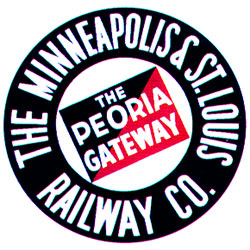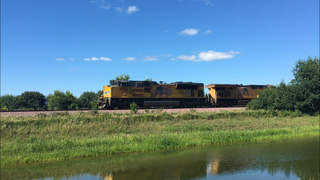
The Chicago, Rock Island and Pacific Railroad was an American Class I railroad. It was also known as the Rock Island Line, or, in its final years, The Rock.

A swing bridge is a movable bridge that has as its primary structural support a vertical locating pin and support ring, usually at or near to its center of gravity, about which the swing span can then pivot horizontally as shown in the animated illustration to the right. Small swing bridges as found over canals may be pivoted only at one end, opening as would a gate, but require substantial underground structure to support the pivot.

The Minneapolis, Northfield and Southern Railway was an 87-mile (140 km) long American shortline railroad connecting Minneapolis and Northfield, Minnesota. It was incorporated in 1918 to take over the trackage of the former Minneapolis, St. Paul, Rochester and Dubuque Electric Traction Company, also known as the Dan Patch Lines. On June 2, 1982, it was acquired by the Soo Line Railroad, which operated it as a separate railroad until merging it on January 1, 1986 along with the Chicago, Milwaukee, St. Paul and Pacific Railroad.

The Midtown Greenway is a 5.7-mile (9.2 km) rail trail in Minneapolis, Minnesota that follows the path of an abandoned route of the Milwaukee Road railway. It is considered under segregated cycle facilities.

The Chicago, St. Paul, Minneapolis and Omaha Railway or Omaha Road was a railroad in the U.S. states of Nebraska, Iowa, Minnesota, Wisconsin and South Dakota. It was incorporated in 1880 as a consolidation of the Chicago, St. Paul and Minneapolis Railway and the North Wisconsin Railway. The Chicago and North Western Railway (C&NW) gained control in 1882. The C&NW leased the Omaha Road in 1957 and merged the company into itself in 1972. Portions of the C. St. P. M. and O. are part of the Union Pacific Railroad network. This includes main lines from Wyeville, Wisconsin, to St. Paul, Minnesota, and St. Paul to Sioux City, Iowa.

The Minneapolis and St. Louis Railway (M&StL) was an American Class I railroad that built and operated lines radiating south and west from Minneapolis, Minnesota for 90 years from 1870 to 1960. The railway never reached St. Louis but its North Star Limited passenger train ran to that city via the Wabash Railroad.

The Robert Street Bridge is a reinforced concrete multiple-arch bridge that spans the Mississippi River in downtown Saint Paul, Minnesota, United States. The bridge is notable for its complex design that was required to accommodate river traffic, the St. Paul Union Pacific Vertical-lift Rail Bridge crossing underneath it at an angle, and roadways on the downtown side of St. Paul. The bridge is also notable for a monumental reinforced concrete rainbow arch. The rainbow arch not only provides 62 feet of headroom above the river, but also provides a strong aesthetic focus. It was built in 1924–1926 by Fegles Construction Company, Ltd. and designed by Toltz, King & Day. The bridge was added to the National Register of Historic Places in 1989. The bridge as well as Robert Street itself are named after Captain Louis Roberts, a notable French Canadian river boat captain, businessman and early settler of Saint Paul, MN.

The Short Line Bridge is a truss bridge that spans the Mississippi River in Minneapolis, Minnesota, United States. It was originally built in the 1880s and upgraded a few years later by Chicago, Milwaukee, St. Paul and Pacific Railroad and was designed by American Bridge Company.

Northern Pacific Bridge #9 is a deck truss bridge that spans the Mississippi River in Minneapolis, Minnesota, between the Seven Corners area and the University of Minnesota campus. It was built in 1924 and was designed by Frederick W. Cappelen. Railroad use of the bridge ended in 1981, and in 1999 the bridge was opened to bicycles and pedestrians. It replaced the former Northern Pacific "A Line" bridge.

The La Crosse Rail Bridge is a swing bridge that spans the Mississippi River between La Crescent, Minnesota and La Crosse, Wisconsin. The first bridge in this location initially was designed and ready to build by June 1876, and was completed in November 1876 by the Milwaukee and St. Paul Railway, a predecessor of the Chicago, Milwaukee, St. Paul and Pacific Railroad. It was later replaced in 1902. It is at the Western end of the Canadian Pacific Railway Tomah Subdivision. Amtrak's Empire Builder crosses this bridge.

Minneapolis BNSF Rail Bridge is a combination plate girder bridge and truss bridge that spans the main channel of the Mississippi River between downtown Minneapolis, Minnesota and Nicollet Island in Minneapolis. It is located adjacent to the current Federal Reserve Bank of Minneapolis.

St. Paul Union Pacific Rail Bridge, also known as the Hoffman Swing Bridge, is a swing bridge that spans the Mississippi River between South Saint Paul, Minnesota and Saint Paul, Minnesota in the United States. It was built in 1910 by the St. Paul Bridge and Terminal Railway, and was rebuilt in 1925, after a flood in 1951, and again in 1982.

The Minneapolis Great Northern Depot, also known as Great Northern Station, was a passenger railroad station which served Minneapolis, Minnesota, USA. It was built in 1913 and demolished in 1978. It was located on Hennepin Avenue next to the Hennepin Avenue Bridge and across the street from the main Minneapolis Post Office.

The Soo Line High Bridge, also known as the Arcola High Bridge, is a steel deck arch bridge over the St. Croix River between Stillwater, Minnesota and Somerset, Wisconsin, United States. It was designed by structural engineer C.A.P. Turner and built by the American Bridge Company from 1910 to 1911. The bridge was listed on the National Register of Historic Places in 1977 for its national significance in the themes of engineering and transportation. It was nominated for its exceptional dimensions, beauty, innovative engineering techniques, and importance to transportation between Minnesota and Wisconsin.

The Rock Island Swing Bridge was a swing bridge that spanned the Mississippi River between Inver Grove Heights, Minnesota, and St. Paul Park, Minnesota. It was also known as the Newport Rail Bridge, as it had a spur to Newport, Minnesota, and J.A.R. bridge, after previous owners Joan and Al Roman of Chicago. It was one of the few double-decker bridges on the Mississippi, with the top level formerly used for railroad traffic and the bottom level formerly used as a road crossing. It also was one of a few toll bridges in Minnesota, and one of the last remaining ones. It closed to rail traffic in 1980, and road traffic in 1999, when the toll was 75 cents. After closing, the bridge sat dormant in the open position for 10 years before being partially demolished in 2009. It was converted into a recreational pier, which was open to the public on June 11, 2011.
The Canadian Pacific Railway's Merriam Park Subdivision or Merriam Park Sub, also known as the Short Line, is a railway line in Saint Paul, Minnesota. It is run by the Soo Line Railroad, a U.S. in-name-only division of CP. It runs from the Saint Paul Yard, also known as the Pigs Eye Yard, westward to the Short Line Bridge over the Mississippi River, where rails continue as part of the Minnesota Commercial Railway. It was named for John L. Merriam, a Minnesota banker and politician. Completed by the Chicago, Milwaukee and St. Paul Railroad in 1880, it shortened the route Milwaukee Road trains took between downtown Saint Paul and downtown Minneapolis. Previous trains would exit Saint Paul and follow the Mississippi River southwest until crossing at Fort Snelling, where they would follow the path of today's Hiawatha Avenue and the Metro Blue Line toward the Milwaukee Road Depot. Originally built as an interurban route, it was eventually converted for heavy rail traffic because the Twin City Rapid Transit streetcar system had taken over the local transit market.
The Mankato Subdivision or Mankato Sub is a railway line operated by the Union Pacific Railroad. It runs generally southwest, starting at Chestnut Street in Saint Paul, Minnesota, where it crosses the Mississippi River, then runs south along the Mississippi and then the Minnesota River to Mankato, where it turns away from the river and continues west to St. James. From there Union Pacific's rails continue southwest toward Sioux City, Iowa, as the railroad's Worthington Subdivision.
The Winona and St. Peter Railroad was a railroad in the Midwestern United States. It was founded in 1861 in Winona, Minnesota. The first 11 miles (18 km) from Winona to Stockton, Minnesota, were completed by the end of 1862, making the it the second operational railroad in Minnesota, after the St. Paul and Pacific Line from Saint Paul to St. Anthony Falls.

The Altoona Subdivision or Altoona Sub is a 90.7-mile (146.0 km) railway line owned and operated by the Union Pacific Railroad in the states of Minnesota and Wisconsin. The line originates in Saint Paul, Minnesota, crosses the St. Croix River on the Hudson Bridge into Hudson, Wisconsin, and eventually terminates in Altoona, Wisconsin where it connects to the Wyeville Subdivision. This subdivision is formerly a Chicago and North Western Railway (C&NW) mainline, on which the Twin Cities 400 operated in the mid 1900s.
The Winona Rail Bridge was a swing bridge that spanned the Mississippi River between Winona, Minnesota, and Winona Junction in Buffalo, Buffalo County, Wisconsin. It was built to link the Winona and St. Peter Railroad with the La Crosse, Trempealeau & Prescott Railroad. Both became part of the Chicago and North Western Transportation Company (C&NW). The swing span was removed, but the box girder portion of the bridge still extends from Latsch Island just downstream of the current Main Channel Bridge. Piers from the original 1871 bridge and the box girders are in the North Channel just downstream of the current North Channel Bridge.

















